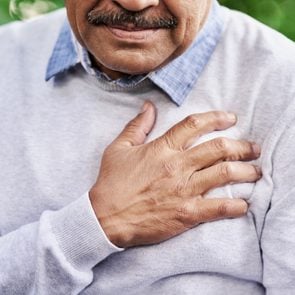What It Means When You Have Chest Pain That Comes and Goes
Updated: Mar. 14, 2022
Random chest pain that comes and goes isn't something you should shrug off. Here's what your chest pain—whether or not it's related to the heart—may be trying to tell you.
Don’t shrug off chest pain that comes and goes
We often think of chest pain as a sign of heart attack, yet chest pain doesn’t automatically mean you have a problem with your heart. There are plenty of other potential culprits—such as heartburn or exercise-related chest pain after a strenuous workout. Both are unpleasant. But neither is serious, like a heart attack.
Still, to be clear: Cardiologists say chest pain is a warning sign you should never dismiss.
“Chest pain of any kind should not be ignored,” says Megan Kamath, MD, a cardiologist and assistant clinical professor of medicine at the University of California Los Angeles’ David Geffen School of Medicine. “You should always seek medical attention if you have chest pain.”
It’s impossible to diagnose yourself when there are so many patient- and disease-specific elements to consider, adds Daniel Cantillon, MD, a cardiologist and associate section head of cardiac electrophysiology and pacing at Cleveland Clinic. “When in doubt, it’s obviously best to err on the side of caution by pursuing a more urgent type of evaluation.”
That includes dialing 911 when you feel that your “symptoms may represent a life-threatening condition in which time is of the essence—for example, acute coronary syndrome, pulmonary embolism, or suspected stroke,” says Dr. Cantillon.
Here’s a look at the serious and not-so-serious reasons why chest pain comes and goes, according to cardiologists.
Types of chest pain
Chest pain runs the gamut from achy and dull to sharp and stabbing. It can vary from person to person, even if the cause is the same. And the type of chest pain or intensity doesn’t necessarily determine whether it is a heart issue or something less serious.
“As a matter of fact, sometimes very severe chest pain such as esophageal spasm or musculoskeletal injury can be very intense whereas heart-related chest pain can be very subtle,” says Dr. Cantillon.
Chest pain in women
Chest pain from heartburn or excessive coughing is similar in women and men. With a heart attack, however, women may experience some surprising symptoms that are different from those experienced by men.
Unlike men, “women are less likely to experience chest pain as the presenting symptom of a heart attack,” says Dr. Cantillon. “Sometimes the symptoms can be more subtle for female patients, such as only pressure or even just difficulty breathing. I advise my female patients at risk for cardiovascular disease on the importance of listening to their bodies, particularly during exercise and/or other vigorous physical activities.”
Women should always trust their instincts and alert their doctor when something doesn’t feel right so that further evaluation can be done. Women are somewhat more likely than men to experience shortness of breath, nausea/vomiting, and back or jaw pain as heart attack symptoms.
According to the American Heart Association, these are the signs of a heart attack. Call 911 and get to a hospital immediately:
- Uncomfortable pressure, squeezing, fullness, or pain in the center of your chest. It lasts more than a few minutes, or comes and goes
- Pain or discomfort in one or both arms, the back, neck, jaw, or stomach
- Shortness of breath with or without chest discomfort
- Breaking out in a cold sweat, nausea, or lightheadedness
Chest pain not related to the heart
There are several reasons why you might feel chest pain that isn’t related to a heart issue. There are muscles, connective tissues, bones, skin, the lungs, esophagus, stomach, and plenty of nerves in the chest area, which is why you often associate your chest pain with a heart condition. Yet the heart organ isn’t furnished with the nerves that many other body parts are.
Chest pain not related to the heart is known as referred pain: You feel the pain in one location, but another source actually causes it. Take heartburn, for example. It is often felt in the chest area, but the pain doesn’t come from the heart itself.
“It’s fair to say that non-cardiac causes of chest pain are a lot more common than cardiac causes,” says Dr. Cantillon. “But the problem is that such symptoms require both a qualitative and contextual assessment to better understand how to investigate them, and what’s the most likely cause.”
For that reason, don’t assume chest pain isn’t serious just because it might not involve the heart. Whether it is cardiac- or non-cardiac-related, you should see your doctor for proper diagnosis and treatment as soon as possible.

Here are some conditions in which chest pain is not related to the heart:
Chest sprain or muscle strain
You might feel chest pain that comes and goes after lifting weights or an injury to the chest area. Treatments typically include rest, ice/heat, and over-the-counter pain and/or anti-inflammatory (NSAIDs) medicine for a strain. Still, an injury to the chest and any chest pain during or after exercise requires medical evaluation. (Ask your doctor about these home remedies for muscle soreness and pain.)
Esophageal spasm
If you’ve ever had heartburn or acid reflux, you might already be familiar with an esophageal spasm. “It is a painful muscular contraction occurring in the lower esophagus,” says Dr. Cantillon. “The pain can vary, but typically it is a sharp, abrupt-onset type.” It may last for a few minutes or hours.
Note, however, that a diffuse esophageal spasm is different from heartburn or reflux. Just because you have experienced reflux does not mean you would have a spasm.
You can try some home remedies for heartburn relief, but frequent heartburn could be a sign you have gastroesophageal reflux disease (GERD), which is inflammation of the esophagus. The esophagus is the tube that connects the mouth to the stomach. Make an appointment with your doctor to discuss your symptoms to get relief and prevent damage to your esophagus.
Costochondritis
“Also referred to as inflammatory arthritis of the sternum/rib cage,” says Dr. Cantillon. “This is a variant of osteoarthritis.” The type of chest pain varies, but it is commonly described as sharp, aching, or pressure.
And it tends to come and go because it is usually provoked by movement in the breastbone/rib cage area.
Rest, ice, moist heat, and nonsteroidal anti-inflammatory medicine (NSAIDs) such as ibuprofen help reduce the pain. (Also, consider trying these natural remedies for arthritis relief.)
As always, call your doctor when you experience chest pain. Even if you have been diagnosed with arthritis or osteoarthritis, your doctor should know if this is chest pain you haven’t experienced before.
Excessive coughing
The common cold or something more severe such as pneumonia, often produces mucus and phlegm, making you cough. Coughing is the body’s way of attempting to clear the lungs of phlegm and mucus, but after a few days of coughing and labored breathing, it can make your chest hurt.
Treatment for the common cold includes over-the-counter medicines for cold, cough, and pain relief. (Don’t hesitate to call when you have these signs that it’s more than a cold.)
Panic attack
It’s hard to tell the difference between a panic attack and a heart attack since they both involve chest pain and have similar symptoms. But the chest pain in a panic attack is localized and can come and go. The chest pain in a heart attack is typically constant and escalating. And it can radiate from the chest to other areas, such as one or both arms, the back, shoulders, abdomen, neck, throat, or jaw.
Still, get medical attention immediately to rule out a heart attack. If the doctor confirms it was a panic attack, here’s some tips to manage a panic attack if you have one again.
Pulmonary embolism
This is a life-threatening condition that occurs when there is blockage of an artery in the lungs, typically caused by a blood clot. Signs of pain or swelling in the legs and chest pain that comes and goes with exertion may be missed or dismissed at first. But this is a condition that requires emergency medical care.
Dr. Cantillon says the symptoms can vary widely. But the chest pain tends to be sudden, intense, and sharp. It’s unprovoked by physical activity and would typically persist beyond a few minutes. The condition requires hospitalization with treatment options such as blood-thinner medication, thrombolytic therapy (“clot buster” drugs), compression stockings, and in some cases, surgery to improve blood flow and minimize new clots from forming.
Shingles
If you’ve ever had chickenpox, you could get shingles later in life. The same virus that causes chickenpox can stick around in your body and be reactivated years or decades later—although getting a shingles vaccine can lower the risk. (It’s recommended that healthy adults get the shingles vaccine at age 50 or older; you generally get one dose followed by a second dose two to six months later.)
Shingles develop in localized areas on the body, most commonly across the chest and back. (Although you can get shingles anywhere, including the arms or face.) Skin is sensitive to the touch, with stinging or tingling. A series of painful blisters eventually form (usually on one side of the body), and the condition can lead to long-term complications and nerve pain in some people.
Shingles can also feel like chest pain. This merits a call to your doctor—not only to rule out a heart condition, but also to get treatment to soothe the symptoms if you do have shingles.
Heart-related chest pain
We can’t say it enough: Chest pain is a warning sign, no matter how it came to be.
“Chest discomfort occurring during exercise and relieved by rest requires medical evaluation,” advises Dr. Cantillon. “Chest pain that comes on at rest and is associated with other symptoms—including, but not limited to, difficulty breathing, dizziness/lightheadedness, nausea, vomiting, or heart palpitations—requires medical evaluation.”
Here are some conditions in which chest pain is related to the heart:
Heart attack
You might assume a heart attack causes only sudden chest pain, but that’s not always the case.
“Intermittent chest pain could be an indicator of a heart attack,” says Dr. Kamath. “A thorough evaluation will need to be done to determine the cause of your symptoms based on your history, physical examination, and diagnostic testing.”
Don’t delay getting help for intermittent or sudden chest pain. Call 911 or go immediately to the hospital.
Aortic dissection
Aortic dissection is a rare yet life-threatening condition that occurs when a tear develops in the inner layer of the aorta artery, leading to a separation of the aorta’s three layers. Dr. Kamath says it can cause intermittent chest pain or sharp, tearing chest pain that often radiates to the shoulders and the back. It more often happens to men between the ages of 60 and 80.
Some common causes include high blood pressure, hardening of the arteries, an aortic valve defect, connective tissue disease, or a traumatic chest injury, like a car accident.
You can’t afford to be indecisive. Call 911 and get to the hospital immediately if you are having this type of chest pain.
Angina
Angina is a term used to describe chest discomfort or pain that happens when your heart doesn’t get enough blood flow and oxygen. “Heart-related chest pain that is reproducibly provoked by physical activity and relieved by rest is often referred to as stable angina,” says Dr. Cantillon.
On the flip side, unstable angina is a condition in which the heart-related pain occurs even when you are not exercising or exerting yourself. “Unstable angina can result when a coronary plaque ruptures and produces heart-related chest pain at rest, or even symptoms that wax and wane in intensity,” says Dr. Cantillon.
Other symptoms include chest pain that radiates to the throat or jaw, tightness or pressure in the chest, and pain down the arms and between shoulder blades.
Don’t hem and haw about what kind of angina it might be. It could be a sign of a heart attack. Call 911 and get to the hospital.
Myocarditis
In simple terms, myocarditis is an inflammation of the heart muscle, usually due to an infection. It can also be caused by a drug reaction or inflammatory condition.
A viral infection can cause myocarditis. For example, Covid-19 is known to trigger myocarditis in some patients, and even people with a relatively mild case of Covid-19 can show signs of heart damage.
Symptoms include chest pain or pain that comes and goes, radiating to the jaw and either arm, fatigue, heart palpitations (myocarditis can cause heart arrhythmias), lightheadedness, shortness of breath after exercise or when lying down, swelling in the hands, legs, ankles, and feet, and sudden loss of consciousness.
Young or old, if you have these symptoms, seek medical attention immediately.
Pericarditis
Pericarditis is inflammation of the pericardium, which is the thin membrane of tissue that surrounds the heart, says Dr. Kamath. “Chest pain may be sharp and stabbing, come and go, and change with position.”
It may be caused by viral, bacterial, or fungal infections and sometimes happens after heart surgery or a heart attack. It can be acute or chronic, with the acute variety making you feel like you are having a heart attack. Acute pericarditis doesn’t usually last long, while chronic develops over time and may take longer to treat.
Neither is good for your heart, as they both upset the heart’s normal rhythm and function. Although they’re rarely life-threatening, there’s no way to tell if the chest pain is from pericarditis or a heart attack.
Don’t waste time, get to a hospital quickly.
Next, here’s the best heart hospital in every state.
























